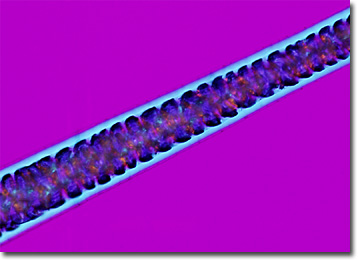Polarized Light Microscopy Digital Image Gallery
Squirrel Hair
Although the family Sciuridae contains more than 250 different species of rodents that live in a wide variety of habitats, most people use the term squirrel to refer to only those that are arboreal. These tree squirrels comprise the subfamily Sciurinae, which contains 122 species in 22 genera.

View a second image of Squirrel Hair
The common name of squirrels is derived from the Greek word skiouros, which means “shade tail,” an allusion to one of their most prominent features. Completely covered in fur and often longer the animal’s body and head combined, the tail is frequently bushy, but may appear flatter depending upon species and the way in which the hair grows. The color of the tail and the rest of the small mammal’s fur vary considerably, ranging from earth tones of gray, brown, and black, to brighter hues of white, yellow, orange, and red. Fur markings and patterns are also rather variable, some of which may be quite complex. Dense and silky to the touch, while inexpensive compared to many other types of fur, squirrel pelts have been utilized in the fur industry throughout history.
Quick and nimble, tree squirrels are able to make their seemingly gravity-defying movements through the trees primarily because of the structure of their feet and ankles. Flexible and rotatable, the joints of their ankles can instantaneously adjust to most any surface, while their slender toes with sharp, pointed claws enable them to hold on. Thus, squirrels can easily accomplish feats, such as descending trees headfirst, at an astonishing pace with very little effort. Such capabilities are invaluable in times of emergency, especially when a hasty retreat from predators is necessary.
